Abstract
Non-pandemic variants of the Human Immunodeficiency Virus Type 1 (HIV-1) subtype B accounts for a significant fraction of HIV infections in several Caribbean islands, Northeastern South American countries and the Northern Brazilian states of Roraima and Amazonas. In this paper, we used a comprehensive dataset of HIV-1 subtype B pol sequences sampled in Amazonas and Roraima between 2007 and 2017 to reconstruct the phylogeographic and demographic dynamics of the major HIV-1 subtype B non-pandemic Brazilian lineage, designated as BCAR-BR-I. Our analyses revealed that its origin could be traced to one of many viral introductions from French Guiana and Guyana into Northern Brazil, which probably occurred in the state of Amazonas around the late 1970s. The BCAR-BR-I clade was rapidly disseminated from Amazonas to Roraima, and the epidemic grew exponentially in these Northern Brazilian states during the 1980s and 1990s, coinciding with a period of economic and fast population growth in the region. The spreading rate of the BCAR-BR-I clade, however, seems to have slowed down since the early 2000s, despite the continued expansion of the HIV-1 epidemic in this region in the last decade.
1. Introduction
According to the last report of the Brazilian Ministry of Health, the number of new Human Immunodeficiency Virus Type 1 (HIV-1) infections remained roughly stable or decreased in most Brazilian states from 2007 to 2017 [1]. In the Northern Brazilian region, by contrast, the HIV epidemic expanded continuously and notable increases in the AIDS incidence rate were recorded in the last decade in the states of Roraima (28%), Amazonas (35%), Para (55%), Amapá (68%) and Tocantins (143%) [1]. In the 2018 AIDS incidence rate ranking of all Brazilian states, Roraima and Amazonas respectively occupyied the first and fourth positions [1].
The HIV-1 subtype B spread in the Americas from a founder strain probably introduced in the island of Hispaniola (shared by Haiti and the Dominican Republic) around the mid-1960s [2,3,4]. Most current subtype B infections are driven by the dissemination of a pandemic clade (BPANDEMIC) that spread worldwide from North America [2,3,4]; however, other ancestral non-pandemic subtype B variants (BCAR) are also detected in the Caribbean region [2,3,4]. Dispersed initially from the island of Hispaniola, the BCAR strains subsequently originated local clades in Trinidad and Tobago (BCAR-TT) and Jamaica in the early 70s [2,3,4]. From Trinidad and Tobago, the BCAR-TT lineage landed in Northern South America in the mid-1970s, producing the most prevalent subtype B non-pandemic clade (BCAR-SA-I) circulating in French Guiana, Guyana, Suriname and Brazil [5].
Multiple BCAR strains were introduced into Brazil, but only some of them established onward transmissions and local clades [5,6]. The major non-pandemic subtype B Brazilian clade previously identified, named BCAR-BR-I, is a tributary of the BCAR-SA-I clade [5] and accounts for an important fraction of HIV-1 subtype B infections in Roraima (~33%) and Amazonas (~15%) [6,7]. Previous analyses support that the BCAR-BR-I clade probably arose by the dissemination of a founder BCAR-SA-I strain from French Guiana into Roraima around the late 1970s [5,6]. Those studies, however, were based on a limited number of BCAR-BR-I sequences mostly (63%) sampled in Roraima, which may have introduced a significant sampling bias on phylogeographic reconstructions. Furthermore, the precise demographic dynamics of this major non-pandemic Brazilian lineage remains unknown.
The recent characterization of new subtype B non-pandemic sequences from Amazonas state [7] allowed us to compile a more comprehensive dataset of 76 HIV-1 BCAR-BR-I pol sequences from Amazonas (n = 45), Roraima (n = 29), Rondonia (n = 1) and Sao Paulo (n = 1), collected between 2007 and 2017. With this new dataset, we obtain a more accurate reconstruction of the spatiotemporal origin of the HIV-1 BCAR-BR-I clade in Northern Brazil and we also infer the demographic dynamics of this lineage for the first time.
2. Materials and Methods
2.1. HIV-1 BCAR pol Sequence Dataset
A total of 76 HIV-1 subtype B pol sequences from Brazil that covered the entire protease and partial reverse transcriptase (PR/RT) regions (nucleotides 2253–3260 relative to HXB2 clone) and were previously classified within the BCAR-BR-I clade [6,7] were used in the present study (Table 1). HIV-1 Brazilian sequences were aligned with subtype BCAR pol sequences from Hispaniola (n = 130), noted as the most probable epicenter of subtype B epidemic, and with BCAR pol sequences representative of the BCAR-TT (n = 41) and BCAR-SA-I clades (n = 69) circulating in Trinidad and Tobago, French Guiana, Guyana and Suriname, that were described as the non-Brazilian lineages most closely related to the BCAR-BR-I clade [3,5,6] (see Table S1 for details about GenBank accession number, geographic origin and sampling time of all HIV-1 BCAR sequences used in this study). Subtype D pol sequences from the Democratic Republic of Congo (DRC) (n = 10), noted as the most probable source location of subtype B strain introduced in the Americas [2], were used as outgroup. Sequences were aligned using the Clustal W program [8], and all sites associated with major antiretroviral drug resistance in PR and RT were excluded. The presence of putative intra-subtype recombinant sequences among the subtype B datasets was analyzed using the RDP4 software [9], with those sequences selected as such by three or more of the algorithms being deemed as recombinant.

Table 1.
Human Immunodeficiency Virus Type 1 (HIV-1) pol (PR/RT) sequence dataset of non-pandemic subtype B variants (BCAR).
2.2. Evolutionary, Phylogeographic, and Demographic Analyses
The evolutionary rate, the age of the most recent common ancestor (TMRCA), the spatial diffusion pattern and the rate of population growth (r, years−1) of HIV-1 BCAR-BR-I clade circulating in Brazil were jointly estimated using the Bayesian Markov Chain Monte Carlo (MCMC) approach as implemented in BEAST v1.10 [10,11] with BEAGLE [12] to improve run-time. Analyses were performed using the GTR + I + Г4 nucleotide substitution model and a relaxed uncorrelated lognormal molecular clock model [13]. Inspection of temporal structure with program TempEst [14] revealed that the BCAR pol dataset compiled here did not contain sufficient temporal signal for reliable time-scale estimations (X-intercept (TMRCA) < 1910). Thus, Bayesian MCMC analyses were performed using a normal prior distribution on the substitution rate (mean = 2.1 × 10−3 substitution/site/year, standard deviation = 1.0 × 10−4) based on previous estimates for the subtype B pol gene [15,16,17,18]. Migration events were reconstructed using a reversible discrete phylogeographic model [19] with a CTMC rate reference prior [20]. Changes in effective population size through time (Ne) were estimated using the non-parametric Bayesian Skygrid (BSKG) model [21]. Estimates of the r were obtained under the best fit parametric model selected using the log marginal likelihood estimation (MLE) based on the generalized stepping-stone sampling (GSS) method [22]. The mean basic reproductive number (R0) was inferred with the formula R0 = rD + 1, where r, the epidemic growth rate, derived from the best fit parametric model, and D, the average duration of the infection, was considered as eight years. Three MCMC chains were run for 200 × 106 generations and then combined using LogCombiner v1.10. Convergence and uncertainty of parameter estimates were assessed by calculating the Effective Sample Size (ESS) and 95% Highest Probability Density (HPD) values, respectively, after excluding the initial 10% of each run with Tracer v1.7 [23]. Convergence of parameters was considered with ESS ≥ 200. The maximum clade credibility (MCC) tree was summarized with TreeAnnotator v1.10 and visualized with FigTree v1.4.4 [24].
3. Results
3.1. Dispersal Pattern of the HIV-1 BCAR Strains from the Caribbean to Brazil
HIV-1 subtype B non-pandemic pol sequences from Brazil, Northern South America and Trinidad and Tobago previously classified as BCAR-BR-I, BCAR-SA-I and BCAR-TT were combined with BCAR sequences from Hispaniola (Table 1) and subsequently subjected to Bayesian phylogeographic reconstructions. The mean estimated evolutionary rate of the HIV-1 BCAR/D pol dataset was 2.0 × 10-3 substitutions/site/year (95% HPD 2.0 × 10−3–2.2 × 10−3 substitutions/site per year), whereas the corresponding median coefficient of rate variation was 0.28 (95% HPD: 0.24–0.34), supporting the selection of a relaxed molecular clock model. Consistent with previous findings [2,3], the origin of the well-supported sub-clades BCAR-TT (posterior probability (PP) = 0.76) and BCAR-SA-I (PP = 0.93) was traced to the sequential viral movement from Hispaniola to Trinidad and Tobago (posterior state probability (PSP) = 0.59) around the early 1970s and from Trinidad and Tobago to French Guiana (PSP = 0.85) around the mid-1970s, respectively (Figure 1 and Figure 2A, Table 2).
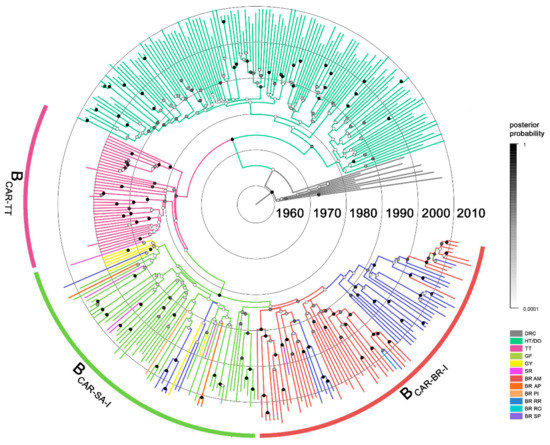
Figure 1.
Time-scaled Bayesian maximum clade credibility (MCC) tree of HIV-1 BCAR pol sequences from Brazil (n = 87), Northern South American countries (n = 58), and the Caribbean (n = 171) and subtype D reference sequences (n = 10) from the Democratic Republic of Congo. Branches are colored according to the most probable location state of their descendent nodes as indicated in the legend at right. Posterior clade probability for all nodes is indicated in the color scale on the right. Branch lengths are depicted in units of time (years). The circular brackets highlight the position of major non-pandemic HIV-1 BCAR clades circulating in Trinidad and Tobago (BCAR-TT), Northern South America (BCAR-SA-I) and Brazil (BCAR-BR-I). The tree was automatically rooted under the assumption of a relaxed molecular clock. DRC: Democratic Republic of Congo; HT/DO: Haiti/Dominican Republic; TT: Trinidad and Tobago; GF: French Guiana; GY: Guyana; SR: Suriname; BR: Brazil; AM: Amazonas; AP: Amapá; PI: Piauí; RR: Roraima; RO: Rondônia; SP: São Paulo.
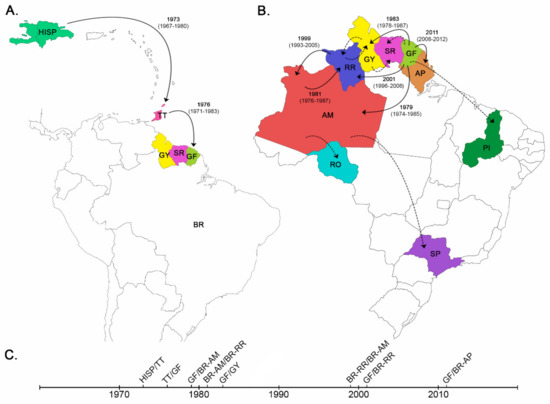
Figure 2.
Spatiotemporal dynamics of the dissemination of non-pandemic HIV-1 BCAR clades in the Caribbean and South American regions. (A,B) Lines between locations represent branches in the Bayesian MCC tree along which location transitions occurred. Migration events that originated secondary outbreaks or sporadic infections with no evidence of subsequent dispersion are represented by solid and dashed lines, respectively. The median TMRCA (and 95% HPD interval) is indicated for the earliest migration events between locations that originated secondary outbreaks. All migration events displayed PSP support ≥ 0.55 and nearly all TMRCA estimates (with the exception of the earliest migration from AM to RR) were estimated from local sub-clades with high support (PP ≥ 0.75). (C) Timeline summarizing the main migratory events. AM: Amazonas; AP: Amapá; GF: French Guiana; GY: Guyana; HISP: Hispaniola; PI: Piauí; RO: Rondônia; RR: Roraima; SP: São Paulo; SR: Suriname; TT: Trinidad and Tobago. Maps were created from templates obtained from d-maps.com [25].

Table 2.
Bayesian the most recent common ancestor (TMRCA) estimates for BCAR clades from South America and the Caribbean.
The BCAR-SA-I lineage rapidly spread across Northern South American countries (French Guiana, Guyana and Suriname) during the 1970s and was then independently disseminated from French Guiana (PSP ≥ 0.97) and Guyana (PSP = 0.98) into Northern Brazil (Amazonas, Amapá and Roraima) at multiple times (Figure 1, Figure 2B). One BCAR-SA-I strain introduced from French Guiana originates the sub-lineage BCAR-BR-I that was successfully disseminated in Amazonas and Roraima. It is interesting to note that the PP support of the lineage BCAR-BR-I increased from 0.56 to 0.85 when Brazilian BCAR-SA-I strains branching outside the major Brazilian clade were removed from analysis. This suggests that some Brazilian BCAR strains may represent mosaic forms between different BCAR-SA-I sub-lineages, despite none of the BCAR sequences included in our analyses been identified as intra-subtype recombinants. Others BCAR-SA-I strains introduced from French Guiana or Guyana in Northern Brazil gave origin to small sub-clades (n ≤ 4) in Roraima (PP = 1) and Amapa (PP = 1), or resulted in sporadic infections with no evidence of subsequent dispersion.
3.2. Dissemination of the HIV-1 BCAR-BR-I Lineage in Northern Brazil
According to our phylogeographic reconstruction, the BCAR-BR-I lineage was most probably introduced in the state of Amazonas (PSP = 0.92) around the late 1970s and was then repeatedly disseminated between Amazonas and Roraima (Figure 1 and Figure 2B). The number of BCAR-BR-I strains from Amazonas (n = 45) included in our dataset was higher than the corresponding number of sequences from Roraima (n = 29), and this sampling bias might confound the Bayesian phylogeographic reconstructions. To test this hypothesis, we constructed two sub-datasets, each randomly containing half of the sequences from Amazonas. When subjected to Bayesian phylogeographic reconstructions, the root location for the BCAR-BR-I clade remained in the state of Amazonas as the most probable hypothesis (PSP > 0.90, Table 3).

Table 3.
Root location of the HIV-1 BCAR-BR-I lineage.
The phylogeographic analysis supports at least four independent disseminations of the BCAR-BR-I lineage from Amazonas (PSP ≥ 0.79) into Roraima. The earliest viral introduction into Roraima was traced to around the early 1980s (Figure 2B), but that migration event was inferred from a large Roraima’s sub-clade with low support (PP = 0.17) and should thus be interpreted with caution. Smaller sub-clades from Roraima with high support (PP > 0.70) point to the local circulation of the BCAR-BR-I lineage in this Northern state from the mid-1980s onwards. Our analysis also reveals at least two independent viral introductions from Roraima (PSP ≥ 0.97) into Amazonas with the subsequent dissemination of one of them, giving origin to a well-supported (PP = 1) Amazonian sub-clade around the late 1990s (Figure 1 and Figure 2B). Sporadic disseminations the BCAR-BR-I lineage from Amazonas to Rondonia (PSP = 0.79) and Sao Paulo (PSP = 1) were also detected, but with no evidence of further local transmission.
Given that the lineage BCAR-BR-I might present different dynamics in each Brazilian state, we reconstruct the demographic history of this lineage with the BSKG model using sequences from both Amazonas and Roraima states (Figure 3A) and only from Amazonas state (Figure 3B). The evolution of the effective population size (Ne) was quite similar in both analyses and supports a sustained exponential growth phase until the early 2000s, followed by a transient period of epidemic stabilization until the mid-2000s, a resumed growth until the late 2000s and a new stabilization phase that extends until the last coalescent event. These results displayed some differences with the temporal trends of the estimated number of new HIV cases in Amazonas (Figure 3C), but roughly matched with those described in Roraima (Figure 3D). According to the epidemiological data, the number of new HIV cases in Amazonas grew continuously until 2005 and then decreased until 2009, while the epidemic in Roraima grew until the early 2000s, remained roughly stable until the mid-2000s and then resumed growth.
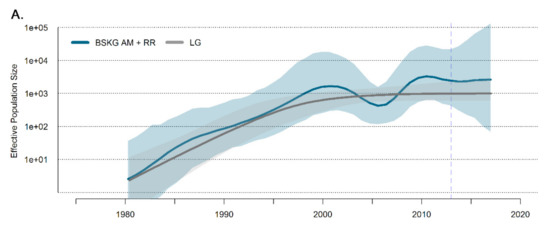
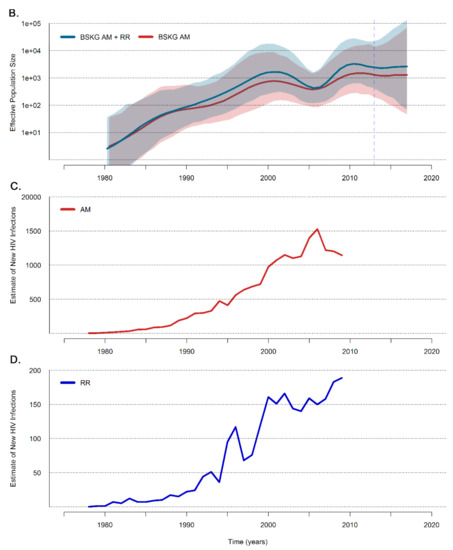
Figure 3.
Demographic history of the HIV-1 BCAR-BR-I clade. (A,B) Median estimate of the effective population size (Ne) for datasets comprising BCAR-BR-I sequences from Roraima and Amazonas (blue line) and from Amazonas only (red line) using the Bayesian Skygrid (BSKG) model along with their 95% highest probability density (HPD) intervals (pale blue and pale red areas). The median Ne estimates provided by the logistic coalescent-based parametric model (LG; dark gray line) and its 95% HPD (pale gray area) are co-plotted in the first graphic. The vertical blue dashed lines indicate the time of the last coalescent event. (C,D) Number of new HIV infections among adults (15+) in Amazonas and Roraima states estimated by subtracting eight years from new AIDS cases notified between 1986 and 2017 [26].
Despite none of the simple parametric coalescent models being able to describe the intricate demographic pattern of the BCAR-BR-I epidemic, the growth rate of the BCAR-BR-I epidemic in Amazonas and Roraima during the first decades was estimated from the logistic growth model (Figure 3A), which was strongly supported over the exponential and expansion models (log BF > 3) (Supplementary Materials Table S2). According to the logistic model, the median initial growth rate of the BCAR-BR-I epidemic was 0.35 (95% HPD: 0.19–0.50), which corresponds to a basic reproductive number (R0) of 3.79 (95% HPD: 2.56–5.03) (Figure 4).
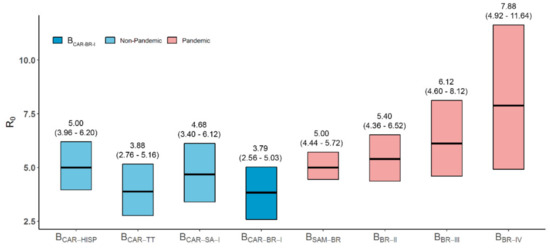
Figure 4.
Coalescent-based estimates of the basic reproductive number (R0) of clade BCAR-BR-I and other major pandemic and non-pandemic HIV-1 subtype B clades circulating in Brazil, Northern South America and the Caribbean. The boxes and the numbers above illustrate the median R0 and the 95% HPD intervals of the posterior distributions estimated under the logistic growth coalescent model for the HIV-1 BCAR-BR-I clade (blue), related Caribbean BCAR clades (light blue) and major Brazilian BPANDEMIC clades (light red). R0 values for clades other than BCAR-BR-I were obtained from previous studies [3,5,27].
4. Discussion
Our phylogeographic analysis revealed multiple introductions of the non-pandemic BCAR-SA-I lineage into the Northern Brazilian states of Amazonas, Amapá and Roraima from neighboring countries (French Guiana and Guyana). Most of those introductions resulted in local transmission chains of small size (< 5 sequences) or dead-end infections, with the only exception of the founder event that originated the most prevalent non-pandemic HIV-1 subtype B Brazilian clade, designated as BCAR-BR-I. These results support that international migration along the Amazonian frontier represents an important driving force for recurrent introductions of non-pandemic subtype B variants into Northern Brazil, although the successful establishment of these variants in the country seems to be a rarer phenomenon.
Our study supports that the BCAR-BR-I clade was the product of a successful transmission chain probably initiated in the Brazilian state of Amazonas around the late 1970s and later disseminated into Roraima. In a previous study conducted by our group, we traced the origin of the BCAR-BR-I clade to the state of Roraima around the late 1970s [6]. In that work, nonetheless, we had to deal with the limitation of analyzing a much larger number of BCAR sequences from Roraima (n = 32) than from Amazonas (n =14), notwithstanding the aforementioned state having, in 2018, a population of HIV-infected individuals over six times larger than Roraima [1]. The current finding that traced the origin of the BCAR-BR-I clade in Amazonas was robust enough to sampling bias as this location was noted as the most probable geographic origin even when phylogeographic reconstructions were conducted with balanced datasets containing a roughly similar number of sequences from both Amazonas and Roraima states.
The origin of the BCAR-BR-I clade in the Amazonas state around the late 1970s is in agreement with available epidemiological and historical information. The first reported AIDS cases in Amazonas dates back to 1986 [1], consistent with the circulation of HIV in the region since the late 1970s. Amazonas has been an important state of transit for Brazilian migrants en route to/from Guyana and Suriname [28] and by 1980, the Amazonas state had a much larger population (~1.5 million people) than Roraima (~82,000 million people), creating a more fertile ground for the establishment of non-pandemic subtype B strains introduced from neighboring Amazonian countries. The recurrent dissemination of BCAR-BR-I strains between Amazonas and Roraima since the early 1980s onwards is also consistent with the intense human flux between both Brazilian states since the inauguration in 1977 of the BR-174 road connecting the state’s capitals [29]. The poor connectivity of Amazonas and Roraima to other Brazilian states might also explain the paucity of BCAR-BR-I strains outside that region.
The population dynamics herein reconstructed for the HIV-1 BCAR-BR-I epidemic in Amazonas and Roraima support an initial phase of exponential growth during the 1980s and 1990s. This exponential growth phase coincides with a constant increase in the number of new HIV cases in the states of Amazonas and Roraima (Figure 3) and also coincides with a significant population (Figure S1) and economic growth driven by the expansion of the local industrial park in Manaus (capital of Amazonas) and the rise of legal/illegal mining activities in Roraima [30,31,32]. Between 1980 and 2000, the population grew from 1.4 million to over 2.8 million individuals in Amazonas and from 82,000 to nearly 325,000 inhabitants in Roraima (Figure S1). These drastic changes in the demographic and economic scenarios certainly create an opportunity for the successful dissemination of HIV.
Demographic reconstruction supports a short phase of stabilization for the HIV-1 BCAR-BR-I epidemic between the early and the mid-2000s, and a resumed period of growth until 2010. This pattern is quite consistent with the temporal changes in the estimated number of new HIV cases in Roraima but differs from the dynamic in Amazonas, where the estimated number of new HIV cases reached a peak in 2005 and declined until 2009. The exclusion of HIV sequences from Roraima imposed only minimal changes to the demographic reconstruction, indicating that the population dynamic of the BCAR-BR-I epidemic might have followed a different trend than the overall HIV epidemic in the Amazonas state during the 2000s. It is important to note that because the BCAR-BR-I clade comprises only a fraction of HIV-1 infections in Amazonas (<14%), its demographic dynamic may be different from other prevalent HIV-1 clades circulating in that Brazilian state. Our demographic reconstruction also supports the recent stabilization of the BCAR-BR-I epidemic before the last coalescent event in 2013.
The median R0 here estimated for the BCAR-BR-I epidemic (3.84) over the first two decades was roughly equivalent to those previously reported for the related BCAR-TT (3.88) and BCAR-SA-I (4.68) clades [3,5], but slightly lower than those described for major BPANDEMIC Brazilian lineages (5.00–7.88) [27] (Figure 4). Although these results must be interpreted with prudence since they exhibit broad and overlapping 95% HPD intervals, the apparent differences in R0 values might reflect large transmissibility of BPANDEMIC compared with BCAR viruses circulating in Brazil or could expose discrepancies in the size and/or connectivity of the underlying transmission networks across different Brazilian regions. Future analyses comparing the R0 values of HIV-1 BPANDEMIC and BCAR transmission clusters circulating in Amazonas and Roraima will be of paramount importance to determine the relative impact of viral and/or transmission chain characteristics on the epidemic potential of different viral subtype B lineages.
Despite the fact that the BCAR-BR-I dataset used in the present work comprises a more geographically balanced dataset than previous studies and that it could be useful for the spatial reconstruction of the lineage’s root, it is feasible that quite a larger number of BCAR-BR-I sequences from Amazonas and Roraima states would be required for understanding the structure and dynamics of the BCAR-BR-I transmission networks in those Northern Brazilian states. Assuming that the BCAR-BR-I infections accounts for approximately 15 and 30% of HIV-1 subtype B infections in Amazonas and Roraima [6,7], respectively, our sampling density probably corresponds to approximately 2–5% of the BCAR-BR-I-infected individuals living in those Brazilian states. Such a sampling density is below the minimal level of 10% suggested by simulation studies for HIV-1 clusters analysis [33].
In summary, this study demonstrates that non-pandemic HIV-1 subtype B strains have been introduced at multiple times from the Northeastern South American region into Northern Brazil. One of these introductions that probably occurred in the state of Amazonas around the late 1970s gave origin to the most prevalent Brazilian BCAR-BR-I clade. The BCAR-BR-I clade was rapidly disseminated from Amazonas to Roraima and the epidemic grew exponentially in these Northern Brazilian states during the 1980s and 1990s, but its spreading rate seems to have slowed down since the early 2000s. The continuous molecular surveillance of major HIV-1 lineages spreading in Northern Brazilian will be crucial to understanding the HIV epidemic dynamics in this singular and changing region.
Supplementary Materials
The following are available online at https://www.mdpi.com/1999-4915/11/10/909/s1, Figure S1: Population evolution in the states of (A) Amazonas and (B) Roraima in the selected period of 1960 to 2010. Table S1: HIV-1 BCAR and subtype D pol sequences used for ML and Bayesian phylogenetic analyses. Table S2: Best fit demographic model for the HIV-1 BCAR-BR-I lineage.
Author Contributions
Conceptualization, G.B.; Data curation, M.A.E.C., M.N.d.G.R. and M.M.A.S.; Formal analysis, I.A. and G.B.; Supervision, G.B.; Writing—original draft, I.A. and G.B.; Writing—review and editing, M.A.E.C., M.N.d.G.R. and M.M.A.S.
Funding
I.A. is funded by a fellowship from the Instituto Oswaldo Cruz—FIOCRUZ. G.B. is funded by fellowships from the Conselho Nacional de Desenvolvimento Científico e Tecnológico - CNPq (Grant number 302317/2017-1) and the Fundação Carlos Chagas Filho de Amparo à Pesquisa do Estado do Rio de Janeiro – FAPERJ (Grant number E-26/202.896/2018).
Conflicts of Interest
The authors declare no conflict of interest. The funders had no role in the design of the study; in the collection, analyses, or interpretation of data; in the writing of the manuscript, or in the decision to publish the results.
References
- Brazilian, Ministry of Health. AIDS Epidemiological Bulletin. Available online: http://www.aids.gov.br/sites/default/files/anexos/publicacao/2015/58534/boletim_aids_11_2015_web_pdf_19105.pdf (accessed on 28 August 2019). (in Portuguese)
- Gilbert, M.T.; Rambaut, A.; Wlasiuk, G.; Spira, T.J.; Pitchenik, A.E.; Worobey, M. The emergence of HIV/AIDS in the Americas and beyond. Proc. Natl. Acad. Sci. USA 2007, 104, 18566–18570. [Google Scholar] [CrossRef] [PubMed]
- Cabello, M.; Mendoza, Y.; Bello, G. Spatiotemporal dynamics of dissemination of non-pandemic HIV-1 subtype B clades in the Caribbean region. PLoS ONE 2014, 9, e106045. [Google Scholar] [CrossRef] [PubMed]
- Junqueira, D.M.; de Medeiros, R.M.; Matte, M.C.; Araujo, L.A.; Chies, J.A.; Ashton-Prolla, P.; Almeida, S.E. Reviewing the history of HIV-1: Spread of subtype B in the Americas. PLoS ONE 2011, 6, e27489. [Google Scholar] [CrossRef][Green Version]
- Bello, G.; Nacher, M.; Divino, F.; Darcissac, E.; Mir, D.; Lacoste, V. The HIV-1 Subtype B Epidemic in French Guiana and Suriname Is Driven by Ongoing Transmissions of Pandemic and Non-pandemic Lineages. Front. Microbiol. 2018, 9, 1738. [Google Scholar] [CrossRef] [PubMed]
- Divino, F.; de Lima Guerra Corado, A.; Gomes Naveca, F.; Stefani, M.M.; Bello, G. High Prevalence and Onward Transmission of Non-Pandemic HIV-1 Subtype B Clades in Northern and Northeastern Brazilian Regions. PLoS ONE 2016, 11, e0162112. [Google Scholar] [CrossRef] [PubMed]
- Esashika Crispim, M.A.; da Guarda Reis, M.N.; Fraiji, N.; Bello, G.; Stefani, M.M.A. Detection of human immunodeficiency virus Type 1 phylogenetic clusters with multidrug resistance mutations among 2011 to 2017 blood donors from the highly endemic Northern Brazilian Amazon. Transfusion 2019, 59, 2593–2601. [Google Scholar] [CrossRef] [PubMed]
- Thompson, J.D.; Gibson, T.J.; Plewniak, F.; Jeanmougin, F.; Higgins, D.G. The CLUSTAL_X windows interface: Flexible strategies for multiple sequence alignment aided by quality analysis tools. Nucleic Acids Res. 1997, 25, 4876–4882. [Google Scholar] [CrossRef] [PubMed]
- Martin, D.P.; Murrell, B.; Golden, M.; Khoosal, A.; Muhire, B. RDP4: Detection and analysis of recombination patterns in virus genomes. Virus Evol. 2015, 1, vev003. [Google Scholar] [CrossRef] [PubMed]
- Drummond, A.J.; Nicholls, G.K.; Rodrigo, A.G.; Solomon, W. Estimating mutation parameters, population history and genealogy simultaneously from temporally spaced sequence data. Genetics 2002, 161, 1307–1320. [Google Scholar] [PubMed]
- Drummond, A.J.; Rambaut, A. BEAST: Bayesian evolutionary analysis by sampling trees. BMC Evol. Biol. 2007, 7, 214. [Google Scholar] [CrossRef]
- Suchard, M.A.; Rambaut, A. Many-core algorithms for statistical phylogenetics. Bioinformatics 2009, 25, 1370–1376. [Google Scholar] [CrossRef] [PubMed]
- Drummond, A.J.; Ho, S.Y.; Phillips, M.J.; Rambaut, A. Relaxed phylogenetics and dating with confidence. PLoS Biol. 2006, 4, e88. [Google Scholar] [CrossRef] [PubMed]
- Rambaut, A.; Lam, T.T.; Carvalho, L.M.; Pybus, O.G. Exploring the temporal structure of heterochronous sequences using TempEst (formerly Path-O-Gen). Virus Evol. 2016, 2, vew007. [Google Scholar] [CrossRef] [PubMed]
- Hue, S.; Pillay, D.; Clewley, J.P.; Pybus, O.G. Genetic analysis reveals the complex structure of HIV-1 transmission within defined risk groups. Proc. Natl. Acad. Sci. USA 2005, 102, 4425–4429. [Google Scholar] [CrossRef] [PubMed]
- Zehender, G.; Ebranati, E.; Lai, A.; Santoro, M.M.; Alteri, C.; Giuliani, M.; Palamara, G.; Perno, C.F.; Galli, M.; Lo Presti, A.; et al. Population dynamics of HIV-1 subtype B in a cohort of men-having-sex-with-men in Rome, Italy. J. Acquir. Immune Defic. Syndr. 2010, 55, 156–160. [Google Scholar] [CrossRef] [PubMed]
- Chen, J.H.; Wong, K.H.; Chan, K.C.; To, S.W.; Chen, Z.; Yam, W.C. Phylodynamics of HIV-1 subtype B among the men-having-sex-with-men (MSM) population in Hong Kong. PLoS ONE 2011, 6, e25286. [Google Scholar] [CrossRef] [PubMed]
- Mendoza, Y.; Martinez, A.A.; Castillo Mewa, J.; Gonzalez, C.; Garcia-Morales, C.; Avila-Rios, S.; Reyes-Teran, G.; Armien, B.; Pascale, J.M.; Bello, G. Human Immunodeficiency Virus Type 1 (HIV-1) Subtype B Epidemic in Panama Is Mainly Driven by Dissemination of Country-Specific Clades. PLoS ONE 2014, 9, e95360. [Google Scholar] [CrossRef]
- Lemey, P.; Rambaut, A.; Drummond, A.J.; Suchard, M.A. Bayesian phylogeography finds its roots. PLoS Comput. Biol. 2009, 5, e1000520. [Google Scholar] [CrossRef] [PubMed]
- Ferreira, M.A.R.; Suchard, M.A. Bayesian analysis of elapsed times in continuous-time Markov chains. Can. J. Stat. 2008, 26, 355–368. [Google Scholar] [CrossRef]
- Gill, M.S.; Lemey, P.; Faria, N.R.; Rambaut, A.; Shapiro, B.; Suchard, M.A. Improving Bayesian population dynamics inference: A coalescent-based model for multiple loci. Mol. Biol. Evol. 2013, 30, 713–724. [Google Scholar] [CrossRef]
- Baele, G.; Lemey, P.; Suchard, M.A. Genealogical Working Distributions for Bayesian Model Testing with Phylogenetic Uncertainty. Syst. Biol. 2016, 65, 250–264. [Google Scholar] [CrossRef] [PubMed]
- Rambaut, A.; Drummond, A.J.; Xie, D.; Baele, G.; Suchard, M.A. Posterior Summarization in Bayesian Phylogenetics Using Tracer 1.7. Syst. Biol. 2018, 67, 901–904. [Google Scholar] [CrossRef] [PubMed]
- FigTree v1.4.4. Available online: http://tree.bio.ed.ac.uk/software/figtree/ (accessed on 28 August 2019).
- d-maps.com. Available online: https://d-maps.com (accessed on 28 August 2019).
- Brazilian, Ministry of Health. Available online: http://www.aids.gov.br/pt-br/taxonomy/term/595 (accessed on 28 August 2019).
- Mir, D.; Cabello, M.; Romero, H.; Bello, G. Phylodynamics of major HIV-1 subtype B pandemic clades circulating in Latin America. AIDS 2015, 29, 1863–1869. [Google Scholar] [CrossRef] [PubMed]
- Corbin, H.P. Brazilian migration to Guyana as a livelihood strategy: A case study approach. Available online: http://www.repositorio.ufpa.br/jspui/bitstream/2011/1966/1/Dissertacao_BrazilianMigrationGuyana.pdf (accessed on 28 August 2019).
- Leonardi, V. Fronteiras Amazonicas do Brasil: Saúde e História Social Brasilia: Paralelo 15; Marco Zero: Sao Paulo, Brazil, 2000. (in Portuguese) [Google Scholar]
- Diniz, A.M.A.; dos Santos, R.O. O vertiginoso crescimento populacional de Roraima e seus impactos socioambientais (in Portuguese). Cad. Geogr. 2005, 15, 23–44. [Google Scholar]
- Vale, A.L.F. Imigração de nordestinos para Roraima. Estud. Avançados 2006, 20, 255–261. (in Portuguese). [Google Scholar] [CrossRef]
- Kadri, M.R.; Schweickardt, J.C. The emergence of Aids in Amazonas. Hist. Cienc. Saude—Manguinhos 2016, 23, 301–319. [Google Scholar] [CrossRef] [PubMed][Green Version]
- Novitsky, V.; Moyo, S.; Lei, Q.; DeGruttola, V.; Essex, M. Impact of sampling density on the extent of HIV clustering. AIDS Res. Hum. Retrovir. 2014, 30, 1226–1235. [Google Scholar] [CrossRef]
© 2019 by the authors. Licensee MDPI, Basel, Switzerland. This article is an open access article distributed under the terms and conditions of the Creative Commons Attribution (CC BY) license (http://creativecommons.org/licenses/by/4.0/).